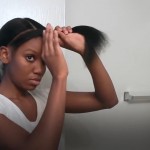What are Protective Hair Styles?
Protective styles are more than just a protective measure for our hair. It is also an opportunity to experiment with different looks and textures that you may not be able to do on wash day. From braids, twists, buns or updos, there are so many options! Protective styles can be done in any texture of hair and work well for those who have busy lifestyles or like to change up their look every now and then. This article will discuss the main types of protective hairstyles as well as some easy ways to achieve them.
Braiding
Braids are a great protective hairstyle that do not require too much maintenance and can last for a few weeks. Braiding is also an option for those who may not have time every week to wash their hair. It’s best if you use braiding hair extensions as this allows you to blend your natural hair with the braiding hair.
This protective hairstyle is durable and can be done with different types of textures including straight, wavy, curly or coily. The braiding pattern or style will vary depending on your hair texture as well.
Braids mainly use three main techniques that are interwoven to create a braid-out look when your hair is taken out.
The basic three types of braiding include the cornrow/continental braid, dutch and french.
Cornrow: The cornrow or continental braid is a very intricate technique that takes a lot of practice. You will need to begin with wash day hair and make sure that your hair is well moisturized before attempting this technique. You will also need a lot of braiding hair to achieve the cornrow braid as it is used for fullness and length.
Dutch Braid: The dutch braid is a classic hairstyle that can be done in any texture of hair with many variations. While there are many ways to do a dutch braid, the basic technique involves parting your hair off to the side and bringing every strand of hair over one shoulder. Alternate which side you bring the sections from and create multiple braids down one shoulder.
French Braid: French braiding is much more simple than a cornrow or continental braid as the base is much smaller. For this style, part your hair in the center and create a regular braid all the way down to your ends. Once you reach the end of your braids, tuck them back into the main braid and secure them with pins or clips.
Twist out/Updo’s: Twists are another easy protective hairstyle that is done in the same manner as braids. One main difference between twists and braids is that you have more options when it comes to styling twist-outs with hair products or leave-in conditioner before taking them down. Twists can also be left out for a few days and styled once they are taken down which is especially convenient for those who do not have time to take them down and style them every day.
Twists are also a fantastic protective hairstyle for the summer as they can be left out until you wash your hair which is an added bonus! One trick to make a twist-out last longer is by putting Braid Sheen or shea butter on your twists before taking them down.
Updo’s are another protective hairstyle that is versatile as it can be made on any texture of hair. There are different variations to updos such as braiding your hair into an up-twist, creating a faux bun or just simply putting your locks into a ponytail or topknot. Braiding hair into an up-twist is one of the easiest updo’s to achieve as you only need a few braiding hair extensions and your natural hair. This style can be done on straight, wavy or curly hair adding dimension and definition to your twist out/braid out!
There are also many tools that can make creating a protective hairstyle easier such as rollers, Flexi rods, and velcro rollers.
Rollers: Rollers are a great way to style your hair in preparation for washing if you do not have the time or energy to wash your hair! To use rollers on wet hair, divide your hair into sections as per the length of your roller. Next, comb all the hair in that section and roller it up. You can also part your hair under or onto the side and roll your hair into a bun for a more secure updo.
If you are using hot rollers, make sure that you turn them on before putting them in your hair as they will get hot very quickly! It is also a good idea to use thermal gloves or caps when using hot rollers as they can get extremely hot and cause burns.
Velcro Rollers: Velcro rollers are used in the same manner as regular rollers except that you will not need clips. The process of rolling your hair with velcro rollers is the same as with hot rollers, you should section your hair off and make sure to put all of your hair into it. Velcro rollers are great for achieving volume which makes them a very popular tool in many salons.
Flexi Rods: Flexi rods are used mainly on relaxed straightened hair but can also be used on wavy hair. Flexi rods are like rollers in that you section off a section of your hair and place the rod in it. The main difference between Flexi rods and hot rollers is that they can be left in for longer periods of time than hot rollers because they do not get as hot. It is also a good idea to use thermal gloves with Flexi rods as they can get very hot and cause burns.
 Twist-outs/Braid outs are a great way to maintain your protective hairstyle while also getting the desired style that you want. If you have not yet tried a twist-out or braid-out, try it out soon! You will love the gorgeous look it gives your hair. Braiding and twisting is a great way to style your hair for those who do not have time or energy to wash their hair daily.
Twist-outs/Braid outs are a great way to maintain your protective hairstyle while also getting the desired style that you want. If you have not yet tried a twist-out or braid-out, try it out soon! You will love the gorgeous look it gives your hair. Braiding and twisting is a great way to style your hair for those who do not have time or energy to wash their hair daily.
Twists are a beautiful protective hairstyle that can be left out in public as they require little maintenance after being taken down. Twisting/braiding is an excellent way to style clean hair as well as a great protective hairstyle. Braiding and twisting is also a fantastic protective style for the summer because it can be left out until you are ready to wash your hair!
Updos are another protective hairstyle that can be worn on any texture of natural hair, they are especially nice in the summertime as they do not require you to take your hair down every day. Braids are also great if you want a style that will last for a while, just simply braid or twist your hair out after washing it.
Braiding and twisting is a beautiful way to protect and style your hair but how long should it stay in for? There are many different strategies for styling your hair in a protective style and they are not just limited to braids. Twists, Marley twists, cornrows and braid outs can all be used as protective hairstyles. However, these styles should be done correctly if you want them to last for a period of time. The following are some tips for styling your hair to last as long as possible.
It is best not to use any kind of moisturizer or oil in your hair when doing a twist out/braid-out because it can make the twists/braids less defined and cause frizziness. Twists are easier to maintain than braid-outs because they can be left in longer. If you are planning on leaving your style in for two weeks or more, it is best to wash every other week with an oil and conditioner mixture. Make sure that all of the products used to moisturize your hair are water-based. The longer that you can leave a twist out or braid out in, the better. However, at some point, you will need to wash your hair because no matter what type of style it is, natural hair needs to be washed! Washing your hair in between styles is important because it allows for your twists/braids to grow in length.
Take Care Of Your Natural Hair
Taking care of your natural hair is necessary if you want to maintain its growth and health. It is important to remember that just because your hair is natural, does not mean that it will take care of itself. You must make sure to wash your hair regularly with products that are specifically made for the cleanliness of natural hair. Also, make sure you keep up with your protective hairstyles and that you do not overdo it.
It is best to wash your hair every two weeks or so, depending on how fast your hair grows. However, this may vary from person to person as many people’s hair will grow at different paces. Many naturalistas can go a month without washing their hair. Some may be able to go longer than a month, while others may only be able to go two weeks. These differences in the frequency of washing hair is mainly due to genetics, texture and density. Naturally, curly hair tends to grow more quickly than straight hair which is why many people with loose curls can wash their hair more often. Having tightly coiled curls will also enable you to wash your hair more often as they tend to grow faster than loose coils or waves.
Remember that the protective styles you wear are still hairstyles and not actual ways for your hair to style itself. It is best to leave Marley twists in for about two months, cornrows can last a few weeks longer than that and braid outs can last a while if you maintain them properly. If you are wearing twists or braids in your hair, it is best to wear headbands so as not to disturb the styles. Do not forget when taking down your Marley twists or cornrows that you should always start from the ends of the hair strands, not at the roots. This is because you can damage your hair with too much manipulation at the scalp. Be sure to wash and condition your hair after taking down your protective hairstyles as this will help them be more defined when you wear them again. Another great tip for making styles last longer is to sleep with a satin scarf on, especially if you are leaving your hair in twists. This will help reduce frizziness and keep the style looking fresh.
Many people wonder if their natural hair has to be washed when they do something strenuous or exercise. The answer is no! You can wash your hair after those activities but it is not necessary for washing your hair to be part of a healthy routine. However, wash your hair after strenuous exercises such as running or training for a marathon to make your hair look and feel better. When you exercise it causes sweat which can cause your natural hair to become dry.
Remember that the conditioner should be left in for at least five minutes before rinsing out. This allows for the conditioner to be absorbed into your hair shaft. Conditioning as often as possible is important because it helps with the natural growth of your hair and makes it stronger. Some people do not like the feeling of having conditioner in their hair, especially products that have silicone or castor oil added to them so you can opt for a water-based conditioner, which has no added texture. However, not everyone can stand the feeling of a water-based conditioner in their hair so silicone and castor oil-based products are also an option. It is important to note that natural hair does not need as much conditioning as relaxed or heat styled hair would.
It is also advised to do a protein treatment on your hair once or twice a month. This will help with the strength and elasticity of your strands. You can do this by buying a pre-made protein treatment and following the instructions or you can make one at home that is tailored to your specific needs.
The bottom line is it is very important to wash, condition, moisturize and protect your hair as often as you are comfortable with, but in the meantime, pay attention to how often other naturalistas wash their hair. Do not pressure yourself to keep up with them because everyone’s hair grows at a different pace. What is important is that you maintain good hygiene for your hair and incorporate protective styles whenever possible.












